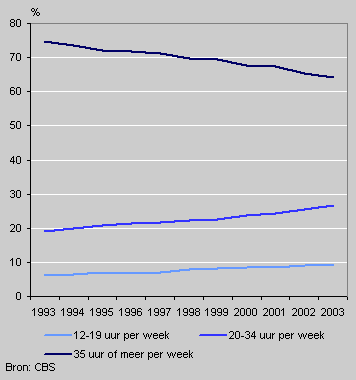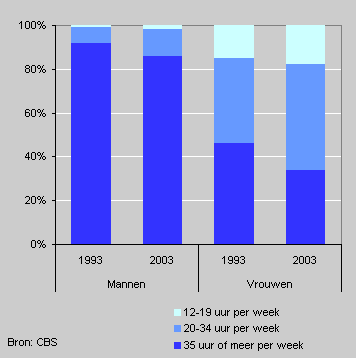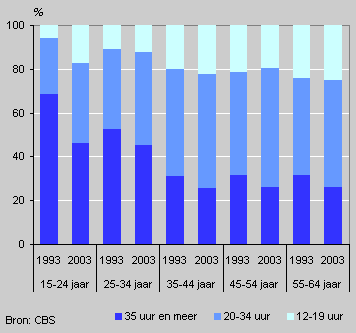Part-time work booming in last decade

In 2003 over one third of the active labour force had a part-time job, nearly one and a half times as many as in 1993. Most part-timers are women but the number of male part-timers is also growing.
Over one third have a part-time job
Part-time work increased from 25 percent in 1993 to 36 percent in 2003. The share of persons with a small part-time job (12-19 hours a week) is almost one and a half times as large as ten years ago. The share of persons with a large part-time job (20-34 hours a week) rose by the same proportion.
People working for less than twelve hours a week do not belong to the employed labour force and are therefore not taken into account.
Active labour force by working hours, 1993-2003

Two-thirds of employed women work part-time
In 1993 over half of employed women had a part-time job. In 2003 two in every three employed women worked on a part-time basis. In the period 1993-2003 almost 800 thousand women joined the labour force. Working part-time is also more common among men. While in 1993 only 9 percent of men worked part-time, their number had risen to 14 percent in 2003. Virtually all male part-timers work 20-34 hours a week.
Working hours of men and women, 1993 and 2003

One quarter of employed women over 35 work full-time
Almost half of women under the age of 35 work full-time. Over the age of 35 the number of women working full-time drops dramatically. Only one quarter of over-35s have a full-time job, half of them have large part-time jobs.
Working hours of women by age, 1993 and 2003

Fewer full-time jobs in all age categories
In the last decade the share of women working full-time dropped in all age categories. The most significant decrease was in the age category 15-24. The share of young women full-timers fell from 69 to 46 percent over the last ten years. Large part-time jobs rose more strongly than small part-time jobs, except for women in the age categories 15-24 and 35-44. In these age categories small and large part-time jobs rose by the same proportion.
Sabine Lucassen